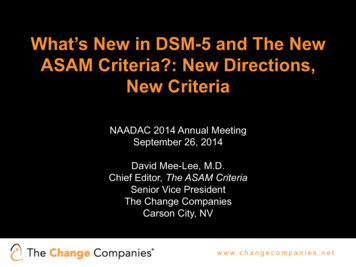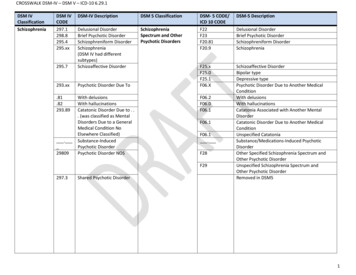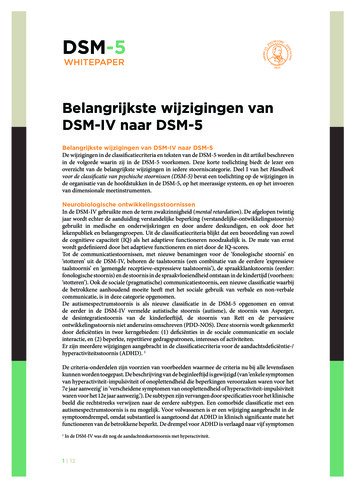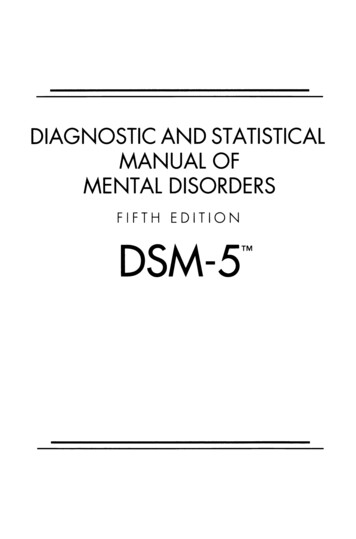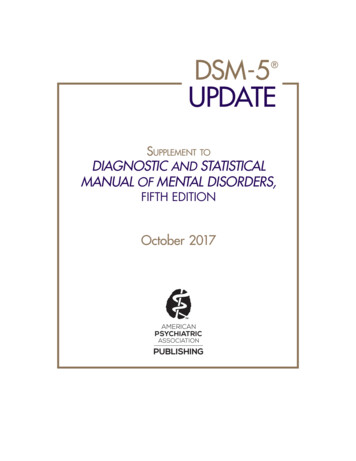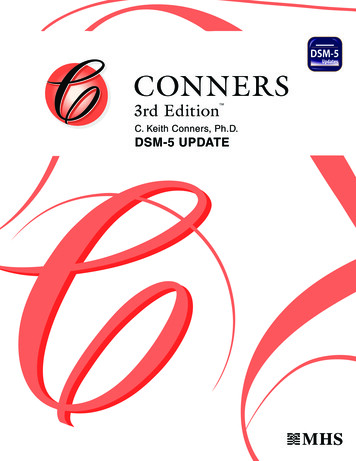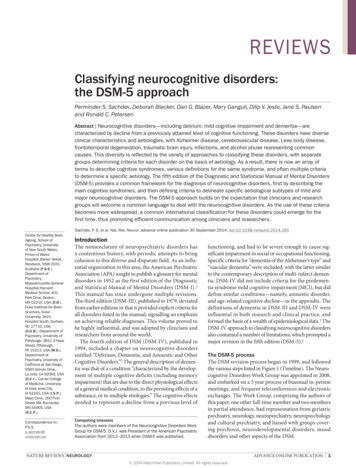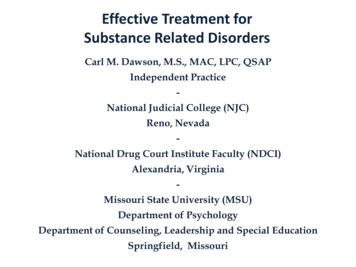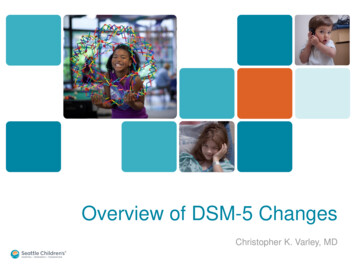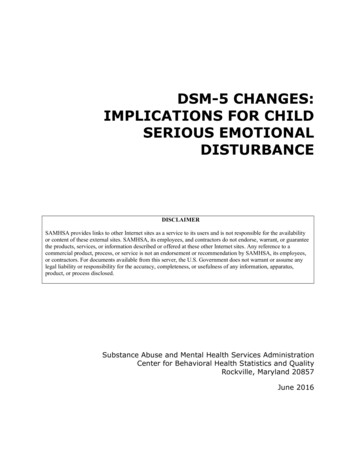
Transcription
DSM-5 CHANGES:IMPLICATIONS FOR CHILDSERIOUS EMOTIONALDISTURBANCEDISCLAIMERSAMHSA provides links to other Internet sites as a service to its users and is not responsible for the availabilityor content of these external sites. SAMHSA, its employees, and contractors do not endorse, warrant, or guaranteethe products, services, or information described or offered at these other Internet sites. Any reference to acommercial product, process, or service is not an endorsement or recommendation by SAMHSA, its employees,or contractors. For documents available from this server, the U.S. Government does not warrant or assume anylegal liability or responsibility for the accuracy, completeness, or usefulness of any information, apparatus,product, or process disclosed.Substance Abuse and Mental Health Services AdministrationCenter for Behavioral Health Statistics and QualityRockville, Maryland 20857June 2016
This page intentionally left blank
DSM-5 CHANGES:IMPLICATIONS FOR CHILDSERIOUS EMOTIONALDISTURBANCEContract No. HHSS283201000003CRTI Project No. 0212800.001.108.008.008RTI Authors:RTI Project Director:Heather RingeisenCecilia CasanuevaLeyla StambaughDavid HunterSAMHSA Authors:SAMHSA Project Officer:Jonaki BoseSarra HeddenPeter TiceFor questions about this report, please e-mail Peter.Tice@samhsa.hhs.gov.Prepared for Substance Abuse and Mental Health Services Administration,Rockville, MarylandPrepared by RTI International, Research Triangle Park, North CarolinaJune 2016Recommended Citation: Center for Behavioral Health Statistics and Quality.(2016). 2014 National Survey on Drug Use and Health: DSM-5 Changes:Implications for Child Serious Emotional Disturbance (unpublished internaldocumentation). Substance Abuse and Mental Health ServicesAdministration, Rockville, MD.
AcknowledgmentsThis publication was developed for the Substance Abuse and Mental Health ServicesAdministration (SAMHSA), Center for Behavioral Health Statistics and Quality (CBHSQ), byRTI International, a trade name of Research Triangle Institute, Research Triangle Park, NorthCarolina, under Contract No. HHSS283201000003C. Contributors to this report include LisaColpe and Peggy Barker. At RTI, Michelle Back edited and Roxanne Snaauw formatted thereport.ii
Table of ContentsChapterPage1.Introduction . 11.1Definition of SED . 11.2Published SED Estimates. 22.DSM-IV to DSM-5 Changes: Overview. 52.1Elimination of the Multi-Axial System and GAF Score . 52.2Disorder Reclassification . 53.DSM-5 Child Mental Disorder Classification . 93.1New Childhood Mental Disorders Added to the DSM-5. 93.1.1 Social (Pragmatic) Communication Disorder (SCD, underNeurodevelopmental Disorders) . 93.1.2 Disruptive Mood Dysregulation Disorder (or DMDD) (underDepressive Disorders) . 113.2Age-Related Diagnostic Criteria Changes to Mental Disorders in the DSM-5 . 163.2.1 Attention-Deficit/Hyperactivity Disorder (ADHD, underNeurodevelopmental Disorders . 163.2.2 Post-traumatic Stress Disorder (PTSD, under Trauma- andStressor-Related Disorders) . 203.3Changes to Other Mental Disorders with Minor to No Implication for SEDPrevalence Estimates . 243.3.1 Major Depressive Episode/Disorder (under Depressive Disorders) . 243.3.2 Persistent Depressive Disorder (formerly Dysthymic Disorder,under Depressive Disorders) . 253.3.3 Manic Episode and Bipolar I Disorder (under Bipolar and RelatedDisorders). 263.3.4 Generalized Anxiety Disorder (under Anxiety Disorders) . 343.3.5 Panic Disorder and Agoraphobia (under Anxiety Disorders) . 353.3.6 Separation Anxiety Disorder (under Anxiety Disorders) . 393.3.7 Social Anxiety Disorder (formerly Social Phobia [Social AnxietyDisorder], under Anxiety Disorders) . 403.3.8 Conduct Disorder (under Disruptive, Impulse-Control, andConduct Disorders) . 423.3.9 Oppositional Defiant Disorder (under Disruptive, Impulse-Control,and Conduct Disorders) . 453.3.10 Eating Disorders (under Feeding and Eating Disorders) . 473.3.11 Body Dysmorphic Disorder (under Obsessive-compulsive andRelated Disorders) . 524.Instrumentation . 555.Summary and Conclusions . 59References . 61iii
List of TablesTablePage1.DSM-IV Childhood Mental Disorders Assessed in Leading Studies with PublishedEstimates of SED . 32.Past 12-month Prevalence of Mental Disorders Based upon the NCS-A, NHANESSpecial Study, and GSMS, by Functional Impairment and Child Age . 43.Disorder Classes Presented by the DSM-IV and DSM-5, as Ordered in DSM-IV . 64.Disorder Classification in the DSM-IV and DSM-5 for Disorders Usually FirstDiagnosed in Infancy, Childhood, or Adolescence . 75.DSM-IV Pervasive Developmental Disorder Not Otherwise Specified (PDD-NOS)to DSM-5 Social (Pragmatic) Communication Disorder (SCD) Comparison . 106.DSM-IV Bipolar Disorder-Manic Episode and Oppositional Defiant Disorder toDSM-5 Disruptive Mood Dysregulation Disorder (or DMDD) Comparison . 127.DSM-IV to DSM-5 Attention-Deficit/Hyperactivity Disorder Comparison . 178.DSM-IV to DSM-5 Post-traumatic Stress Disorder Comparison Children 6 Yearsand Younger . 219.DSM-IV to DSM-5 Major Depressive Episode/Disorder Comparison . 2510.DSM-IV to DSM-5 Dysthymic Disorder/Persistent Depressive DisorderComparison . 2611.DSM-IV to DSM-5 Manic Episode Criteria Comparison . 2812.DSM-IV to DSM-5 Bipolar I Disorder Comparison . 2913.DSM-IV to DSM-5 Generalized Anxiety Disorder Comparison . 3414.Panic Disorder and Agoraphobia Criteria Changes from DSM-IV to DSM-5 . 3615.DSM-IV to DSM-5 Separation Anxiety Disorder Comparison. 3916.DSM-IV to DSM-5 Social Phobia/Social Anxiety Disorder Comparison. 4117.DSM-IV to DSM-5 Conduct Disorder Comparison . 4318.DSM-IV to DSM-5 Oppositional Defiant Disorder Comparison . 4619.DSM-IV to DSM-5 Anorexia Nervosa Comparison . 4820.DSM-IV to DSM-5 Bulimia Nervosa Comparison . 4921.DSM-IV to DSM-5 Binge Eating Disorder Comparison. 5022.DSM-IV to DSM-5 Avoidant/Restrictive Food Intake Disorder Comparison . 5223.DSM-IV to DSM-5 Body Dysmorphic Disorder Comparison . 5424.Summary of Diagnostic Instruments Used to Assess Child Mental Disorders . 55iv
This page intentionally left blankv
1. IntroductionThe Diagnostic and Statistical Manual of Mental Disorders (DSM) is the manual used byclinicians and researchers to diagnose and classify mental disorders (including substance usedisorders [SUDs]). The DSM specifically classifies child disorders by symptoms, duration, andfunctional impact across home, school, and other community settings. The American PsychiatricAssociation (APA) published the DSM-5 in 2013, culminating a 14-year revision process. Thislatest revision takes a new approach to defining the criteria for mental disorders—a lifespanperspective. This perspective is very relevant to diagnosing childhood mental disorders. Theperspective recognizes the importance of age and development in the onset, manifestation, andtreatment of mental disorders. The purpose of this report is to describe the differences betweenthe DSM-IV and DSM-5 diagnostic criteria that could affect national estimates of childhoodserious emotional disturbance (SED). The report also provides a description of DSM-5 updatesthat have been made (or are being made) to existing diagnostic instruments and screeners ofchildhood emotional and behavioral health.1.1Definition of SEDThe DSM has never offered a definition of SED. This term has been defined historicallyby the Substance Abuse and Mental Health Services Administration (SAMHSA) and released asa Federal Register notice. The SAMHSA definition was crafted in order to inform state blockgrant allocations for community mental health services provided to children with an SED andadults with a serious mental illness (SMI). The Federal Register definition is intended to identifyand estimate the size of the group of children with SED within the general population of eachstate. An accurate and up-to-date estimate of childhood SED is critical for SAMHSA to planfuture block grant allocations and financial supports to states serving children with SED.The Federal Register notice defines the terms "children with a serious emotionaldisturbance" and "adults with a serious mental illness" (SAMHSA, 1993, p. 29422). Pub. L. 102321 defines children with an SED to be people "from birth up to age 18 who currently or at anytime during the past year have had a diagnosable mental, behavioral, or emotional disorder ofsufficient duration to meet diagnostic criteria specified within the Diagnostic and StatisticalManual of Mental Disorders, Third Edition, Revised (DSM-III-R; American PsychiatricAssociation, 1987) that resulted in functional impairment, which substantially interferes with orlimits the child's role or functioning in family, school, or community activities" (SAMHSA,1993, p. 29425).The 1992 and 1993 Federal Register notices also offer several notes that are helpful inconsidering the age, symptom duration, and diagnostic exclusions related to the definition ofchildhood SED: Age: "Although the definition of SED in children is restricted to persons up to age 18, itis recognized that some states extend this age range to persons less than age 22. Toaccommodate this variability, states using an extended age range for children's servicesshould provide separate estimates for persons below age 18 and persons aged 18 to 22within block grant applications" (SAMHSA, 1993, p. 29425).1
Duration: "The reference year refers to a continuous 12-month period because this is afrequently used interval in epidemiological research and because it relates to commonlyused [state] planning cycles" (SAMHSA, 1993, p. 29425). Diagnostic exclusions: "These disorders include any mental disorders listed in the DSMIII-R with the exception of DSM-III-R "V" codes, substance use and developmentaldisorders, which are excluded unless they co-occur with another diagnosable seriousemotional disturbance" (SAMHSA, 1993, p. 29425).A November 6, 1992, Federal Register notice requests public comments to a preliminarydefinition of childhood SED (SAMHSA, 1992). The May 20, 1993, Federal Register describesresponses to public comments received in response to the 1992 notice. Public comments to theproposed SED definition primarily focused on the impairment criteria, with support forconsidering a broad definition of impairment and also concerns that including less impairingdisorders would dilute resources for those with the most severely debilitating conditions. Asmaller set of comments focused on the inclusion or exclusion of certain disorders such assubstance abuse, developmental disorders, and attention deficit disorder.The 1993 Federal Register offers clarification on final decisions about disorders to beincluded and excluded in the SED definition. Public comments included concerns about whetherattention-deficit disorder (ADD) should be included for two main reasons: (1) parental concernsabout the negative stigma associated with labelling ADD as a "serious emotional disturbance"and (2) treatment providers/educators noting difficulties making definitive ADD diagnoses.Ultimately, ADD was included in the definition of SED because "a significant group of childrenwith functional impairments associated with this disorder might otherwise be excluded fromservice" (p. 29423). SUDs were excluded based upon the rationale that the federal governmentadministered a separate state block grant intended to fund substance abuse treatment andprevention services. Developmental disorders (mental retardation, autism, pervasivedevelopmental disorders) were also excluded. The rationale described for this decision was asfollows: "while comments received cited the frequent involvement of mental health practitionersin treatment planning and service delivery for these individuals (particularly autistic children),separate Federal block grant funds and processes for needs assessment cover these populationgroups" (SAMHSA, 1993, p. 29424). Finally, DSM-III "V" codes were excluded because "theyrepresent conditions that may be a focus of treatment but are not attributed to a mental disorder"(p. 29424).In summary, DSM mental disorder classifications are relevant to SED as they form thebasis for an essential part of the SED criteria—the presence of a DSM-based mental disorder.Changes in the number of mental disorders (as defined by the DSM) that fall under theoperationalized definition of SED, and breadth of the diagnostic criteria for existing DSM-basedmental disorders might impact the prevalence rates of SED. The current operationalizeddefinition of SED may need to be updated to ensure consistent and precise measurement of theprevalence of SED within epidemiological studies at the national level.1.2Published SED EstimatesThree large-scale epidemiological studies have provided estimates of SED based uponthe administration of child and adolescent diagnostic interviews. These studies include a2
supplemental study to the National Health and Nutrition Examination Survey (NHANES;Merikangas et al., 2010), the National Comorbidity Survey Adolescent Cohort (NCS-A; Kessleret al., 2012), and the Great Smoky Mountain Study (GSMS; Costello, Mustillo, Erkanli, Keeler,& Angold, 2003). These three studies assess slightly different age groups, use differentdiagnostic instruments, and include the assessment of slightly different childhood mentaldisorders (see Table 1). The disorders assessed in these studies reflect diagnostic categories to beconsidered when estimating the prevalence of SED.Table 1.DisorderCategoryDSM-IV Childhood Mental Disorders Assessed in Leading Studies with PublishedEstimates of SEDNCS-A (13–17 years)Composite InternationalDiagnostic Interview(CIDI)NHANES (8–15 years)Diagnostic InterviewSchedule for Children(DISC)GSMS (9–16 years)Child and AdolescentPsychiatric Assessment(CAPA)MoodDisorderMajor depressionDysthymiaBipolar disorderMajor depressionDysthymiaAnxietyDisordersGeneralized anxiety disorderPanic disorderAgoraphobiaSpecific phobiaSeparation anxiety disorderPosttraumatic stress disorderGeneralized anxiety disorderPanic disorderMajor depressionDysthymiaBipolar disorderManiaDepression NOSGeneralized anxiety disorderPanic disorderAgoraphobiaSimple phobiaSeparation anxiety disorderPosttraumatic stress disorderObsessive compulsivedisorderADHDConduct disorderADHDConduct disorderEating disorderOppositional defiant disorderAlcohol abuseDrug abuseEating isBehaviorDisordersSubstanceDisordersOtherSocial phobiaADHDConduct disorderOppositional defiant disorderAlcohol abuseDrug abuseEating disordersADHD attention-deficit/hyperactivity disorder; NOS not otherwise specified.Each study defines SED to include any assessed DSM-IV Axis I disorder. The R.C.Kessler et al. (2012) and Costello et al. (2003) publications include substance disorders withinthe SED estimates, while the Federal Register definition of SED excludes substance abuse."Serious functional impairment" is defined differently in each study based upon how the study'sdiagnostic interview measured impairment. One study, (Costello et al., 2003), defined SED usingthe Child and Adolescent Psychiatric Assessment (CAPA) as any Axis I disorder with"significant functional impairment." CAPA-based definitions of SED include a child who(1) meets diagnostic criteria for at least one of the assessed Axis I disorders by parent or childreport, and (2) has a report of any partial or severe impairment rating by parent or child report3
(personal communication with G. Keeler, October 2012). R.C. Kessler et al. (2012) defined theserious impairment criteria for SED as a Children's Global Assessment Scale (CGAS) score of50 or less (having moderate functional impairment in most areas of living or severe impairmentin at least one area). Moderate impairment was defined as one or more Axis I disorders plus aCGAS score of 51 to 60 (variable functioning with sporadic difficulties in several but not allareas of living). Meanwhile, Merikangas and colleagues (2010) operationalized four levels ofimpairment for each disorder assessed: level A, intermediate or severe rating on one question;level B, intermediate or severe rating on two questions (level A and B are not mutuallyexclusive); level C, severe rating on one question; and level D (severe impairment), includedmeeting criteria for either level B or C. Impairment items assessed impairment in six domains,including interference with the respondent's own life, family life, social life, peers, teachers, andschool performance. "Any DSM-IV Disorder with Severe Impairment," or SED, was defined as acase with level D impairment.These definitions of SED result in prevalence estimates that range from 6.8 to 11.5percent depending on the study and age of children included (see Table 2). The followingsections of this report describe how recent updates to the DSM may or may not result in likelychanges to these prevalence estimates of SED. This report does not summarize DSM-IV toDSM-5 changes to SUDs since they are excluded from the Federal Register definition of SED.Another SAMSHA report Impact of the DSM-IV to DSM-5 Conversion on the National Surveyon Drug Use and Health and the Mental Health Surveillance Study includes a detaileddescription of changes from DSM-IV to DSM-5 for SUDs among youths aged 12 to 17 years(Center for Behavioral Health Statistics and Quality, in review).Table 2.Past 12-month Prevalence of Mental Disorders Based upon the NCS-A, NHANESSpecial Study, and GSMS, by Functional Impairment and Child AgeAny DSM-IVDisorderSED (andassociateddefinition)Disorder withmoderate orsevereimpairment inany area of livingNCS-A (13-17 years)Past 12 MonthsPrevalence Estimate (%, SE)NHANES Special NHANES SpecialStudy (12-15Study (8-11 years)years)Past 12 MonthsPast 12 MonthsGSMS (9-16years)Past 3 Months42.6 (1.2)13.4 (1.2)12.8 (1.3)13.38.0 (1.3)Moderate impairmentrating in most areas ofliving or severe in 1area11.5 (1.3)Level A or B:Intermediateimpairment rating on2 of 6 items or atleast 1 severe ratingNot provided11.0 (1.1)Level A or B:Intermediateimpairment rating on2 of 6 items or atleast 1 severe ratingNot provided6.8Any Axis I plus"significantfunctionalimpairment"17.8 (n/a)Moderate impairmentwas defined as variablefunctioning, withsporadic difficulties inseveral, but not allareas of living.4Not provided
2. DSM-IV to DSM-5 Changes: OverviewThe American Psychiatric Association (APA) published the DSM-5 in 2013. This latestrevision takes a lifespan perspective recognizing the importance of age and development on theonset, manifestation, and treatment of mental disorders. Other changes in the Diagnostic andStatistical Manual of Mental Disorders, 5th ed. (DSM-5) include eliminating the multi-axialsystem; removing the Global Assessment of Functioning (GAF score); reorganizing theclassification of the disorders; and changing how disorders that result from a general medicalcondition are conceptualized. Many of these general changes from Diagnostic and StatisticalManual of Mental Disorders, 4th ed. (DSM-IV) to DSM-5 are summarized in the report Impactof the DSM-IV to DSM-5 Changes on the National Survey on Drug Use and Health. This reportwill supplement that information by providing details specifically about changes to disorders ofchildhood and their implications for generating estimates of child serious emotional disturbance(SED).2.1Elimination of the Multi-Axial System and GAF ScoreOne of the key changes from DSM-IV to DSM-5 is the elimination of the multi-axialsystem. DSM-IV approached psychiatric assessment and organization of biopsychosocialinformation using a multi-axial formulation (American Psychiatric Association, 2013b). Therewere five different axes. Axis I consisted of mental health and substance use disorders (SUDs);Axis II was reserved for personality disorders and mental retardation; Axis III was used forcoding general medical conditions; Axis IV was to note psychosocial and environmentalproblems (e.g., housing, employment); and Axis V was an assessment of overall functioningknown as the GAF. The GAF scale was dropped from the DSM-5 because of its conceptual lackof clarity (i.e., including symptoms, suicide risk, and disabilities in the descriptors) andquestionable psychometric properties (American Psychiatric Association, 2013b).Although the impact of removing the overall multi-axial structure in DSM-5 is unknown,there is concern among clinicians that eliminating the structured approach for gathering andorganizing clinical assessment data will hinder clinical practice (Frances, 2010). However, thedirect impact on the prevalence rates of childhood mental disorders is likely to be negligible as itwill not affect the characteristics of diagnoses.2.2Disorder ReclassificationDSM-IV and DSM-5 categorize disorders into "classes" with the intent of groupingsimilar disorders (particularly those that are suspected to share etiological mechanisms or havesimilar symptoms) to help clinician and researchers use of the manual. From DSM-IV to DSM-5,there has been a reclassification of many disorders that reflects a better understanding of theclassifications of disorders from emerging research or clinical knowledge. Table 3 lists thedisorder classes included in DSM-IV and DSM-5. In DSM-5, six classes were added and fourwere removed. As a result of these changes in the overall classification system, numerousindividual disorders were reclassified from one class to another (e.g., from "mood disorders" to"bipolar and related disorders" or "depressive disorders"). The reclassification of disorder classes5
will not have a direct effect on any SED estimation; however, it does warrant consideration whendocumenting disorders that may have changed classes.Table 3.1.Disorder Classes Presented by the DSM-IV and DSM-5, as Ordered in DSM-IVDSM-IV4.5.Disorders usually first diagnosed in infancy,childhood, or adolescenceDelirium, Dementia, and Amnestic and othercognitive disordersMental Disorders due to a general medicalconditionSubstance-related disordersSchizophrenia and other psychotic disorders6.Mood Disorders7.8.9.10.11.Anxiety DisordersSomatoform DisordersFactitious DisordersDissociative DisordersSexual and Gender Identity Disorders2.3.12. Eating Disorders13. Sleep Disorders14. Impulse-Control Disorders not elsewhereclassified15. Adjustment Disorders16. Personality DisordersN/AN/AN/AN/AN/AN/A1Dropped1DSM-517. Neurocognitive DisordersDropped116. Substance-Related and Addictive Disorders2. Schizophrenia Spectrum and Other PsychoticDisorders3. Bipolar and Related Disorders4. Depressive Disorders5. Anxiety Disorders9. Somatic Symptom and Related DisordersDropped18. Dissociative Disorders13. Sexual Dysfunctions14. Gender Dysphoria19. Paraphilic Disorders10. Feeding and Eating Disorders12. Sleep-Wake Disorders15. Disruptive, Impulse-Control, and Conduct DisordersDropped118. Personality Disorders1. Neurodevelopmental Disorders6. Obsessive-Compulsive and Related Disorders7. Trauma- and Stressor-Related Disorders11. Elimination Disorders20. Other Mental Disorders21. Medication-Induced Movement Disorders and OtherAdverse Effects of MedicationA notation of "dropped" does not imply that the specific disorders were removed; rather the overall classificationis not included in DSM-5. Disorders in those classes were mainly recategorized.Of particular note for childhood mental disorders, the DSM-5 eliminated a class of"disorders usually first diagnosed in infancy, childhood, or adolescence." Those disorders arenow placed within other classes. See Table 4 for a summary the new DSM-5 disorder classes forthose disorders formally classified as "disorders usually first diagnosed in infancy, childhood, oradolescence."6
Table 4.Disorder Classification in the DSM-IV and DSM-5 for Disorders Usually FirstDiagnosed in Infancy, Childhood, or AdolescenceDisorder Types (version)Mental Retardation (DSM-IV)Intellectual Disabilities (DSM-5)Learning DisordersMotor Skills DisorderCommunication DisordersPervasive Developmental Disorders(DSM-IV)Autism Spectrum Disorder ct DisorderOppositional Defiant DisorderFeeding and Eating Disorders ofInfancy or Early ChildhoodTic DisordersElimination DisordersSeparation Anxiety DisorderSelective MutismReactive Attachment DisorderDSM-IV Disorder ClassDSM-5 Disorder ClassDisorders usually first diagnosed ininfancy, childhood, or adolescenceDisorders usually first diagnosed ininfancy, childhood, or adolescenceDisorders usually first diagnosed ininfancy, childhood, or adolescenceDisorders usually first diagnosed ininfancy, childhood, or adolescenceDisorders usually first diagnosed ininfancy, childhood, or adolescenceNeurodevelopmental DisordersDisorders usually first diagnosed ininfancyDisorders usually first diagnosed ininfancyDisorders usually first diagnosed ininfancyDisorders usually first diagnosed ininfancyDisorders usually first diagnosed ininfancyDisorders usually first diagnosed ininfancyDisorders usually first diagnosed ininfancyDisorders usually first diagnosed ininfancyDisorders usually first diagnosed ininfancyNeurodevelopmental Disorders7Neurodevelopmental DisordersNeurodevelopmental DisordersNeurodevelopmental DisordersNeurodevelopmental DisordersDisruptive, Impulse-Control, andConduct DisordersDisruptive, Impulse-Control, andConduct DisordersFeeding and Eating DisordersNeurodevelopmental DisordersElimination DisordersAnxiety DisordersAnxiety DisordersTrauma- and Stressor-RelatedDisorders
This page intentionally left blank8
3. DSM-5 Child Mental DisorderClassificationThe Diagnostic and Statistical Manual of Mental Disorders, 5th ed. (DSM-5) includeschanges to some key disorders of childhood. Two new childhood mental disorders were added inthe DSM-5: social communication disorder (or SCD) and disruptive mood dysregulation disorder(or DMDD). There were age-related diagnostic criteria changes for two other mental disordercategories particularly relevant to the definition of serious emotional disturbance (SED):attention-deficit/hyperactivity disorder (ADHD) and post-traumatic stress disorder (PTSD). AnADHD diagnosis now requires symptoms to be present prior to the age of 12 (rather than 7, theage of onset from the Diagnostic and Statistical Manual of Mental Disorders, 4th ed. [DSMIV]). PTSD includes a new subtype specifically for children younger than 6 years of age.Sections 3.1 and 3.2 provide detailed descriptions of these disorders as well as summariesof the research that has been conducted around their impact on the prevalence of childhoodmental disorders. Other disorders did not have specific DSM-5 changes related to childhood, butthese changes would be relevant to both adults and children (e.g., major depressive disorder[MDD], generalized anxiety disorder [GAD]). Section 3.3 provides a brief overview of DSM-5changes to these remaining disorders. In the report sections that follow we reference prevalencerates found in studies of community samples using the DSM-5. For some disorders, we alsoreference preva
or content of these external sites. SAMHSA, its employees, and contractors do not endorse, warrant, or guarantee the products, services, or information described or offered at these other Internet sites. Any reference to a commercial product, process, or service is not an endorsement or recommendation by SAMHSA, its employees, or contractors.
